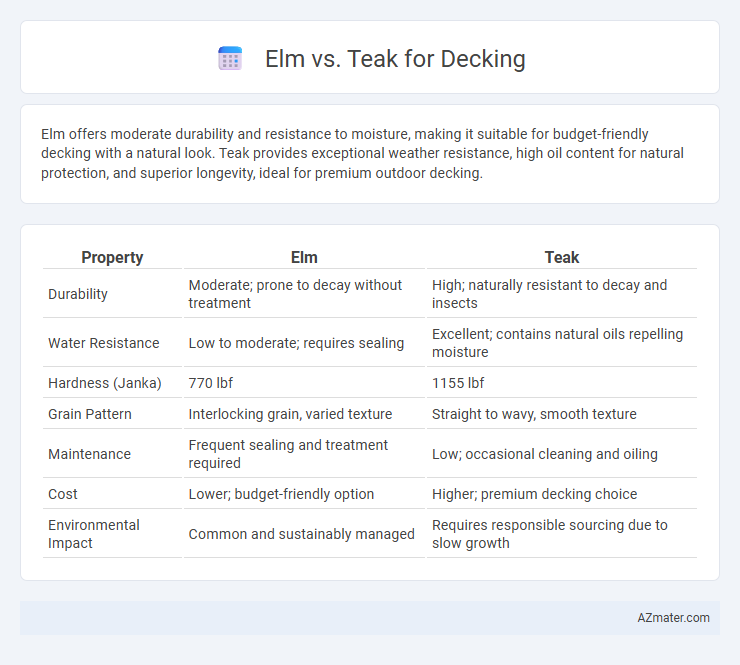Elm offers moderate durability and resistance to moisture, making it suitable for budget-friendly decking with a natural look. Teak provides exceptional weather resistance, high oil content for natural protection, and superior longevity, ideal for premium outdoor decking.
Table of Comparison
| Property | Elm | Teak |
|---|---|---|
| Durability | Moderate; prone to decay without treatment | High; naturally resistant to decay and insects |
| Water Resistance | Low to moderate; requires sealing | Excellent; contains natural oils repelling moisture |
| Hardness (Janka) | 770 lbf | 1155 lbf |
| Grain Pattern | Interlocking grain, varied texture | Straight to wavy, smooth texture |
| Maintenance | Frequent sealing and treatment required | Low; occasional cleaning and oiling |
| Cost | Lower; budget-friendly option | Higher; premium decking choice |
| Environmental Impact | Common and sustainably managed | Requires responsible sourcing due to slow growth |
Introduction: Choosing the Right Wood for Decking
Elm offers strong resistance to decay and a unique grain pattern, making it a durable and attractive choice for decking in various climates. Teak, renowned for its natural oils and high silica content, provides exceptional weather resistance and longevity, often preferred for upscale outdoor projects. Evaluating factors such as durability, maintenance, and aesthetic appeal helps homeowners select the ideal wood to ensure a long-lasting and beautiful deck.
Elm vs Teak: Overview and Key Differences
Elm offers a durable and moderately resistant wood ideal for decking with a distinctive grain and moderate cost, while teak is renowned for its exceptional natural oils, superior weather resistance, and high durability, making it a top choice for premium outdoor decking. Elm's softer texture and variable resistance require more maintenance and sealing compared to teak, which withstands moisture, pests, and decay with minimal treatment. The key differences lie in teak's higher price point, unmatched longevity, and low upkeep versus elm's affordability, aesthetic appeal, and need for regular care.
Appearance and Aesthetic Qualities
Elm decking showcases a rich, warm grain with a natural luster and interlocking grain patterns that create a visually dynamic surface, ideal for rustic and traditional settings. Teak offers a sleek, golden-brown hue that ages into a sophisticated silver-gray patina, prized for its smooth texture and timeless elegance in modern and classic decks. Both woods provide unique aesthetic qualities, with elm emphasizing character and warmth while teak delivers luxury and durability through its refined appearance.
Durability and Longevity Comparison
Teak wood offers superior durability and longevity due to its natural oils that resist water, decay, and insect damage, making it an ideal choice for decking in harsh weather conditions. Elm, while moderately durable, lacks the same level of natural resistance and typically requires additional treatment to protect against rot and insect infestation. Over time, teak decking maintains structural integrity and appearance far better than elm, delivering a longer-lasting investment with minimal maintenance.
Resistance to Weather, Rot, and Pests
Teak offers superior resistance to weather, rot, and pests due to its natural oils and dense grain, making it an ideal choice for outdoor decking exposed to harsh conditions. Elm, while moderately durable, is more susceptible to moisture damage and insect infestations, requiring regular maintenance and protective treatments to extend its lifespan. The inherent durability of teak ensures longer-lasting structural integrity and reduced maintenance compared to elm in decking applications.
Maintenance Requirements for Decking
Elm decking requires regular sealing and cleaning to prevent moisture damage and wood decay due to its moderate natural resistance to rot. Teak offers superior maintenance benefits with its natural oils that resist water, insects, and rot, often needing only occasional cleaning without sealing. Both woods benefit from periodic inspections, but teak's dense grain significantly reduces overall upkeep compared to elm.
Environmental Impact and Sustainability
Elm decking offers moderate sustainability due to its faster growth rate and widespread availability, making it a more renewable choice compared to teak. Teak is highly durable and resistant to decay, but its slow growth and prevalence of illegal logging practices raise significant environmental concerns. Certified sustainable sources and effective forest management crucially reduce the ecological footprint of both woods in decking applications.
Cost and Value Analysis
Teak decking commands a higher upfront cost, often ranging between $20 to $45 per square foot, due to its natural oils, durability, and resistance to rot, making it a long-term investment with excellent value retention. Elm, typically less expensive at $10 to $20 per square foot, offers moderate durability and aesthetic appeal but requires more maintenance and may not provide the same lifespan or weather resistance as teak. When analyzing cost versus value, teak ultimately delivers superior return on investment through longevity and low maintenance, whereas elm suits budget-conscious projects with shorter-term usage expectations.
Suitability for Outdoor Use and Climate Adaptation
Elm wood, with its moderate natural durability and resistance to moisture, performs well in temperate climates but requires proper sealing for prolonged outdoor use. Teak is highly suitable for decking due to its exceptional natural oils and dense grain structure, providing superior resistance to water, decay, and insects, making it ideal for humid or coastal environments. Climate adaptation favors teak for harsh, wet weather conditions, while elm suits drier, moderate climates where maintenance is more manageable.
Conclusion: Which Wood is Best for Your Deck?
Teak outperforms elm for decking due to its superior durability, natural resistance to rot and insects, and low maintenance requirements, making it ideal for long-lasting outdoor use. Elm offers a unique appearance but is less resistant to weathering and decay, requiring regular treatment to maintain its integrity. For a high-performance, low-maintenance deck, teak is the preferred choice, especially in climates with heavy moisture exposure.

Infographic: Elm vs Teak for Decking
 azmater.com
azmater.com